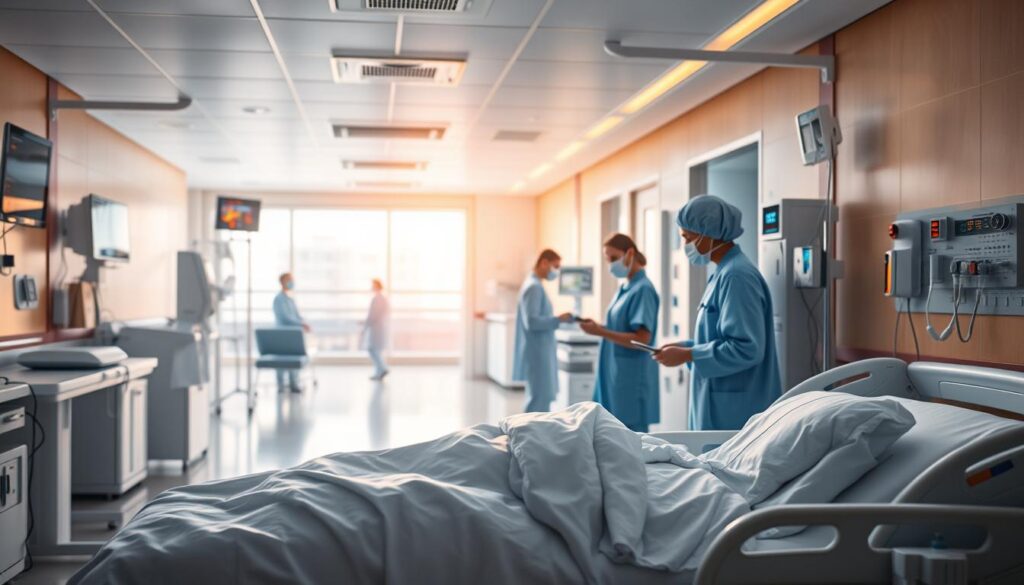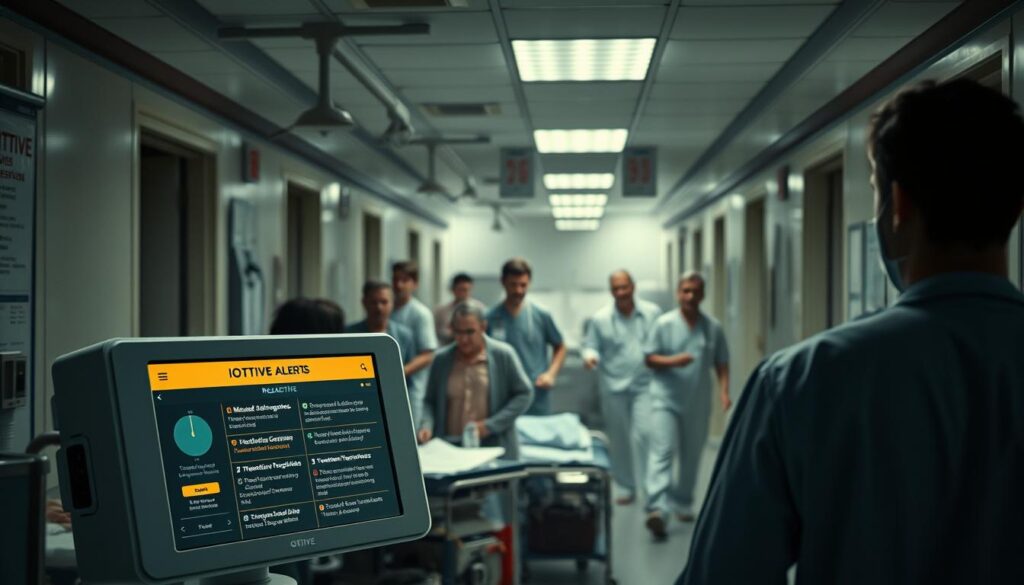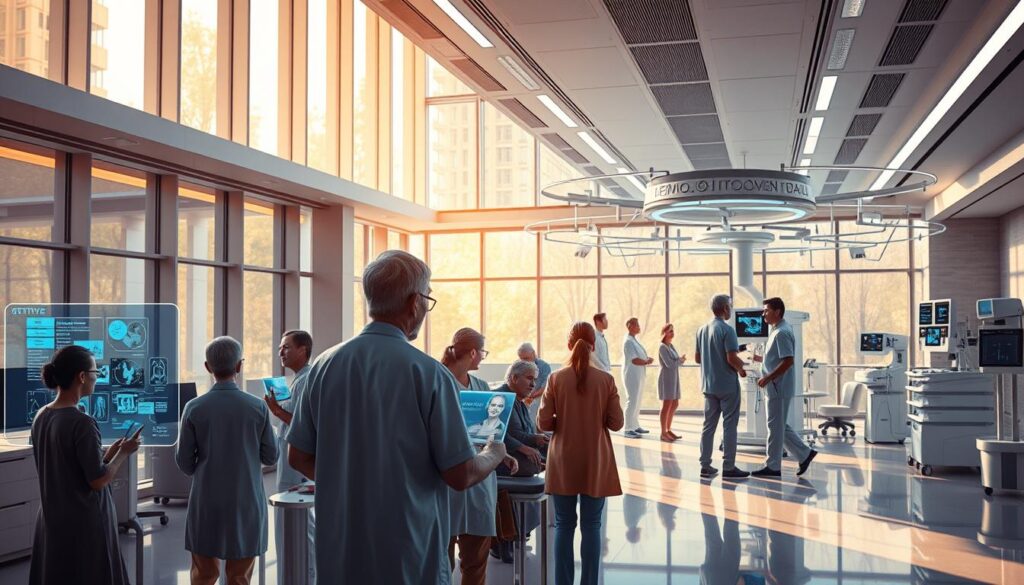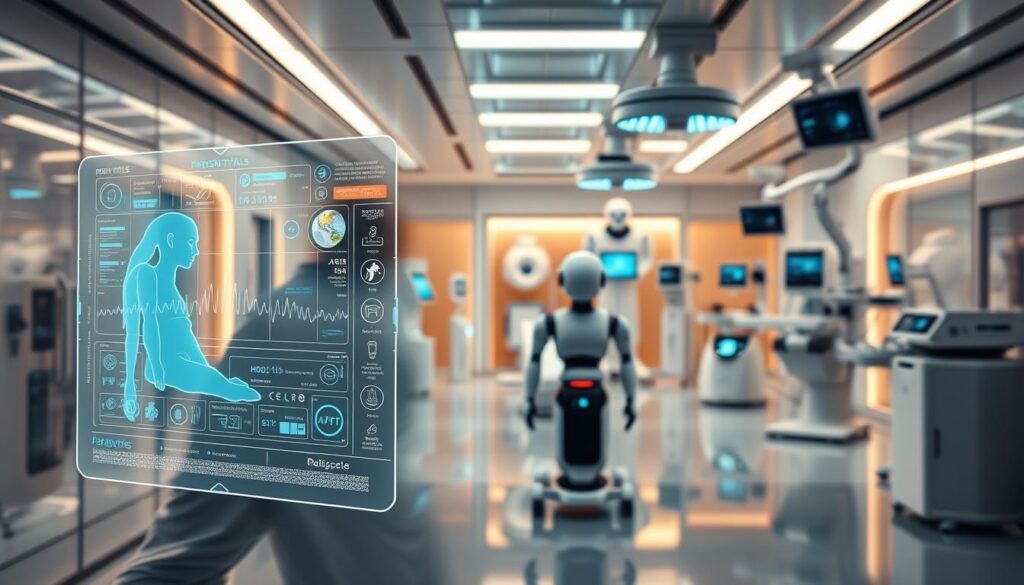Imagine a nurse at a bustling Midwest hospital noticing a pattern in vital sign data before a critical event occurs. Instead of rushing to respond to an emergency, her team uses real-time analytics to adjust treatment plans early. This shift from “waiting for problems” to anticipating risks is reshaping modern medicine.

Healthcare has long focused on fixing issues after they arise. Think of it like repairing a car only when it breaks down. But new technologies now help providers spot potential concerns before they escalate. Automated systems track trends in health data, while AI tools flag subtle warning signs humans might miss.
These innovations create a protective shield around care environments. Teams collaborate using shared dashboards that highlight risks in simple visuals. Training programs emphasize prevention over reaction, building confidence among staff and trust with those they serve.
Key Takeaways
- Modern healthcare prioritizes early risk detection over post-crisis responses
- Data analytics and AI tools enable real-time health monitoring
- Automated systems reduce human error in critical care scenarios
- Collaborative tech platforms improve team communication
- Prevention-focused training enhances care quality outcomes
Understanding the Journey from Reactive to Proactive in Healthcare
For decades, hospitals operated like fire departments – scrambling to address emergencies only after alarms sounded. This “wait-and-see” mindset dominated care delivery, with teams treating complications like infections or organ damage after they occurred.

How Traditional Systems Operate
Most facilities still rely on staff to spot and report issues manually. For instance, a nurse might notice a patient’s rising creatinine levels days into kidney-straining medication use. By then, damage often becomes irreversible. Research shows these manual reporting systems miss 86% of harm events, leaving care teams unaware of recurring risks.
When Reaction Falls Short
Delayed responses create ripple effects. A University of Utah case revealed how late sepsis detection led to extended ICU stays and preventable costs. “We’d review incidents months later,” shares a safety director, “but couldn’t undo the trauma families endured.”
Paper-based tracking and fragmented communication further slow improvements. Clinicians juggle urgent tasks while trying to document past errors – like drivers focusing on rearview mirrors instead of road hazards ahead.
Integrating Proactive Patient Safety Strategies
Picture a radar system scanning the horizon for storms instead of waiting for floodwaters to rise. That’s how modern care teams now approach risks – spotting trouble long before alarms sound. By blending real-time data with human expertise, they’re rewriting the rules of care delivery.

Benefits of Forward-Thinking Care
Automated tools scan medical records 24/7, flagging subtle patterns like medication conflicts or early infection signs. One Midwest ICU reduced sepsis cases by 40% using these alerts. “It’s like having an extra set of eyes that never blink,” says a nurse practitioner.
Teams also share insights faster through centralized dashboards. When blood sugar trends dip, dietitians and pharmacists collaborate instantly – no more waiting for shift reports. This constant vigilance helps catch 68% more potential issues than traditional methods.
Two Models, Different Outcomes
Let’s break down how approaches differ:
| Reactive Model | Proactive Model |
|---|---|
| Relies on incident reports | Analyzes live data streams |
| Focuses on past errors | Predicts future risks |
| Manual documentation | Automated pattern detection |
The military’s “left of bang” philosophy drives this shift. Instead of reacting to crises, teams train to prevent them. As one hospital director notes: “We’re not just putting out fires anymore – we’re fireproofing the building.”
This evolution from fixing problems to avoiding them altogether creates ripple effects. Families spend fewer nights in waiting rooms, and care teams regain time for meaningful interactions. It’s not just safer – it’s smarter.
Establishing a Culture of Safety Through Best Practices
Picture a morning huddle where nurses, doctors, and technicians openly discuss potential risks before rounds begin. This collaborative spirit forms the backbone of modern safety-first environments, where every voice matters in preventing errors.

Effective Communication Protocols in Healthcare
Clear dialogue saves lives. Teams using standardized tools like SBAR (Situation-Background-Assessment-Recommendation) reduce miscommunication by 33%. Daily briefings and digital platforms ensure everyone knows:
- Current treatment plans
- Medication updates
- Critical lab results
Shift changes become safer when using checklists that verify handoff completeness. One Texas hospital cut missed alerts by 50% after implementing visual confirmation techniques.
Adherence to Regulatory Safety Guidelines
Leading healthcare organizations follow strict frameworks from:
- ANA infection control standards
- CDC vaccination protocols
- Joint Commission medication rules
Regular audits help teams stay compliant while identifying improvement areas. “Guidelines aren’t restrictions,” notes a CMS advisor. “They’re guardrails keeping care on track.”
Utilizing Evidence-Based Practices
The Hierarchy of Controls shapes modern risk management:
- Remove hazards completely
- Replace dangerous processes
- Install safety engineering features
Ongoing training keeps staff updated on new research. Simulation labs let teams practice emergency responses safely, building muscle memory for real crises. When knowledge meets action, quality outcomes follow naturally.
Technological Innovations Driving Smart Healthcare
Modern medicine now operates like a precision watch – intricate systems working in sync to protect well-being. Advanced tools scan mountains of data, spotting hidden patterns that human eyes might overlook. This digital transformation turns treatment plans into living documents that adapt as conditions change.

Automated Surveillance and Early Intervention
Think of automated monitors as tireless guardians working round-the-clock. Platforms like the Health Catalyst Patient Safety Monitor analyze lab results, medication orders, and vital signs simultaneously. One Midwest hospital reduced pressure injuries by 35% after implementing these alerts. “The system flagged subtle skin changes we’d typically catch during shift changes,” shares a wound care specialist.
Leveraging Data Analytics for Safety Monitoring
Predictive models now act as crystal balls for care teams. Machine learning algorithms cross-reference thousands of data points to forecast risks:
| Active Safety Systems | Passive Safety Systems |
|---|---|
| Real-time medication alerts | Fall risk scoring |
| Infection pattern detection | Pressure ulcer predictors |
| Drug interaction warnings | Readmission likelihood models |
These tools eliminate guesswork by providing actionable insights. As one data engineer explains: “We’re not just collecting numbers – we’re translating them into life-saving stories.” Organizations using combined systems report 42% fewer preventable incidents compared to single-solution approaches.
Continuous learning algorithms refine their accuracy with each case study. What begins as general guidance becomes tailored protection over time – like personalized armor against medical risks.
Enhancing Team Collaboration and Communication
Consider a symphony orchestra where musicians blend their skills to create harmony. Modern healthcare teams achieve similar coordination through structured collaboration. By breaking down silos between departments, organizations foster environments where collective expertise drives better results.
Building Multidisciplinary Response Teams
Diverse specialists – from surgeons to social workers – now strategize together using shared digital workspaces. Johns Hopkins researchers found these teams reduce treatment errors by 28% compared to solo decision-making. Real-time messaging platforms let members flag concerns instantly, like medication conflicts spotted by pharmacists during rounds.
Weekly case reviews encourage knowledge sharing across roles. “Our neonatal unit improved outcomes by inviting respiratory therapists to planning meetings,” notes a Boston hospital director. This cross-pollination of ideas strengthens care quality while respecting each discipline’s unique contributions.
Establishing Clear Channels for Staff Feedback
Frontline workers often spot risks first. Secure mobile apps now let nurses and technicians report concerns anonymously. One Arizona network saw 40% faster hazard resolution after implementing this approach.
Monthly “innovation hours” give staff paid time to suggest process improvements. A Vanderbilt study linked such programs to 19% higher health outcome scores. When teams know their voices matter, they become active partners in safeguarding those they serve.
These strategies transform workplaces into learning ecosystems. Shared knowledge becomes preventive power, turning everyday interactions into opportunities for growth. It’s not just about working together – it’s about advancing together.
FAQ
What’s the difference between reactive and proactive approaches in healthcare?
Reactive methods focus on addressing issues after they occur, like treating complications or analyzing errors post-event. Proactive strategies prioritize preventing harm upfront through tools like predictive analytics, staff training, and real-time monitoring to reduce risks before they escalate.
How do smart technologies improve care quality?
Innovations like AI-driven analytics and automated systems identify patterns in data to flag potential risks early. For example, wearable devices track vital signs continuously, alerting teams to intervene before a condition worsens, leading to faster, more personalized care.
Why is communication critical in safety culture?
Clear communication ensures everyone—from nurses to specialists—shares updates, concerns, and solutions openly. Hospitals like Johns Hopkins use structured tools like SBAR (Situation-Background-Assessment-Recommendation) to standardize handoffs, reducing miscommunication errors.
What role do regulatory guidelines play in safety?
Guidelines from agencies like The Joint Commission set standards for infection control, medication safety, and emergency protocols. Compliance ensures organizations meet baseline requirements while fostering accountability and consistency across teams.
Can data analytics really prevent adverse events?
Yes. Systems like Epic’s predictive models analyze historical and real-time data to identify high-risk patients or workflow gaps. This allows teams to allocate resources strategically, such as increasing staff during peak admission times to avoid delays.
How can staff contribute to proactive safety measures?
Frontline workers often spot risks first. Encouraging feedback through platforms like Press Ganey surveys or internal apps empowers them to report near-misses or suggest improvements, creating a collaborative environment where prevention is a shared goal.
What metrics track the success of safety strategies?
Key indicators include reduced hospital-acquired infections, shorter response times to critical alerts, and lower readmission rates. Regular audits and patient outcome reviews help organizations refine their approaches over time.
Transform Your IoT Vision Into Reality.
Get free expert insights, architectures & cost breakdowns.
Drop your email to schedule free meeting.